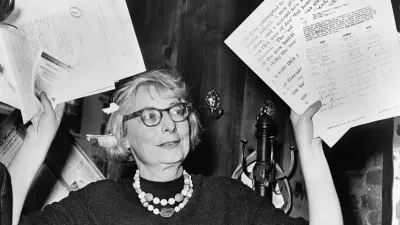An article by Woodbury University Professor Anthony Fontenot examines the effects of a history of opposition to planning as a centralized arm of the state, and proposes a way forward.

Anthony Fontenot provides a historic survey of arguments against planning to find a contemporary world suffering the effects of the lack of planning. Fontenot begins by stating the dilemma—that "even as metropolitan regions face increasingly severe and structural problems — water scarcity, cyclical flooding, atmospheric pollution, housing affordability, failing infrastructure — the capacity of cities to counter these problems is diminishing."
Then Fontenot proceeds to survey the history of intellectuals, designers who have argued against planning as an enemy of freedom. The survey begins with one of the "fundamental challenges to design in the 20th century"—that of Austrian-British economist Friedrich August Hayek. "In his influential mid-century treatise, The Road to Serfdom, Hayek argued that design — specifically, socialist or state-based planning — belonged to a zeitgeist characterized by a 'passion for a conscious control of everything.'"
Fontenot follows the lineage of Hayek's arguments through the Independent Group and the New Brutalists, Reyner Banham, Learning from Las Vegas, Rem Koolhaas, and more.
Fontenot does not, however, conclude by renewing these arguments and applying them to the contemporary world. Instead, he arrives at the following assertion: "As the focus on environmental issues has intensified in the past decade, as first sustainability and now resilience have become new mantras, the limitations of 'non plan' or 'no plan' have become ever clearer. And the environmental implications are only the most obvious. If as a discipline we thought we understood the history — and the shortcomings — of planning, it’s increasingly evident that we’ve paid comparatively little attention to the history of 'non planning' — to the tumultuous consequences of the lack of a plan."
Finally, Fontenot concludes by citing example of a new middle way, provided by Medellín in Colombia.
FULL STORY: Notes Toward a History of Non-Planning

Maui's Vacation Rental Debate Turns Ugly
Verbal attacks, misinformation campaigns and fistfights plague a high-stakes debate to convert thousands of vacation rentals into long-term housing.

Planetizen Federal Action Tracker
A weekly monitor of how Trump’s orders and actions are impacting planners and planning in America.

In Urban Planning, AI Prompting Could be the New Design Thinking
Creativity has long been key to great urban design. What if we see AI as our new creative partner?

Massachusetts Budget Helps Close MBTA Budget Gap
The budget signed by Gov. Maura Healey includes $470 million in MBTA funding for the next fiscal year.

Milwaukee Launches Vision Zero Plan
Seven years after the city signed its Complete Streets Policy, the city is doubling down on its efforts to eliminate traffic deaths.

Portland Raises Parking Fees to Pay for Street Maintenance
The city is struggling to bridge a massive budget gap at the Bureau of Transportation, which largely depleted its reserves during the Civd-19 pandemic.
Urban Design for Planners 1: Software Tools
This six-course series explores essential urban design concepts using open source software and equips planners with the tools they need to participate fully in the urban design process.
Planning for Universal Design
Learn the tools for implementing Universal Design in planning regulations.
Gallatin County Department of Planning & Community Development
Heyer Gruel & Associates PA
JM Goldson LLC
City of Camden Redevelopment Agency
City of Astoria
Transportation Research & Education Center (TREC) at Portland State University
Jefferson Parish Government
Camden Redevelopment Agency
City of Claremont





























